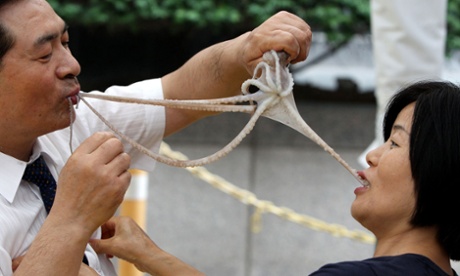Noma's prawn with ants. Photograph: Kayoubidesu/Instagram
The Danish restaurant's Japanese pop-up has hit the headlines for its 'live' seafood. Food writer Joe Warwick waited tables and tried the still-twitching crustacean.
It is just shy of 2am and I'm sitting at a 24-hour sushi bar in Tsukiji market, Tokyo. I've just had some of the best nigiri of my life, and I'm watching the chef who sliced my fish dip a set of very long chopsticks into a tank behind the bar. It looks as though he's trying to grab a rather large and lively mackerel. My immediate thought is that he's going to make it into sashimi, ikizukuri-style.
My basic Japanese (I spent a week in Tokyo getting by in restaurants with sumimasen, hai, omakase, kanjou o onegaishimasu and arigato) means that it takes a while to get to the bottom of what's actually going on. "Sashimi?" I eventually ask, with a concerned look on my face. The chef smiles and shakes his head. "Pet," he says. "Six years old." He'd been tickling his pet mackerel. We all laugh and I take another gulp of sake. I love sushi and sashimi, the fresher the better, but I'm relieved. A live fish being dispatched, sliced and served up inches away from me is not something I want to see.
This might sound a bit hypocritical given I'd just finished working a double shift as a waiter at Noma's five-week residency at the Mandarin Oriental, where the curtain-raising first serving of 15 courses is a still-twitching prawn served on a bowl of ice, its tail shelled and seasoned with ants. It is not the most original or creative dish on the impressive Nordic-goes-Nippon menu, but it's definitely eye-catching, provocative and, predictably, the one that has attracted the most attention so far. It has made its way around the world via countless Twitter and Instagram posts, websites and newspaper pages.
Noma has done variations on this before. They served live ants with a dollop of creme fraiche on a lettuce leaf when they came to London in 2012. Back in 2010, at Noma in Copenhagen, they served potted shrimp with a difference: small live shrimps dipped in a brown butter emulsion and served on ice in a Kilner jar. This was after first using a langoustine, a crustacean they returned to serving at their restaurant last year.
In Tokyo, Rene Redzepi's team have used different prawns depending on what is available. When I sample the dish, it is made with a plump botan ebi, about the size of a langoustine but much creamier. The 10 or so dead ants that stud its body, billed on the menu as "flavours of the Nagano forest", are from the northern prefecture where there is a tradition of eating insects. They add a citrus-like tang.
But the main difference here is that these crustaceans aren't actually alive. They are dispatched with a spike to the brain just before serving. The twitching antennae and jumping around are just electrical impulses; Noma's "live" prawn is actually just a piece of food theatre that cleverly short-circuits the crustacean's nervous system.

Japan has a tradition of eating live seafood, from shirouo - dancing ice fish - in Fukuoka prefecture in the south-west of the country, to the more widespread practice of odori ebi - dancing prawn - a form of sashimi where the prawn is dipped in a sauce and eaten alive, while the head and shells are deep-fried and served as a side dish. A variation on the dancing prawn - goong ten - is served in Thailand. In Hyderabad in southern India, people eat small live sardines, believing that they are a cure for asthma. I could go on.
I might not want to try any of these dishes, but what really leaves a bad taste in my mouth is not that they exist in various eating cultures around the world, but that they are exploited by desperate TV chefs and squirming tourists who post their extreme eating on YouTube as a bit of a lark. All this has helped spawn a macho eating culture that understandably winds up Peta.
The only other "live" seafood dish that I've tried is sannakji, a Korean dish of twitching baby octopus that I sampled in Seoul several years ago. In the version I ate, the raw octopus was cut up into pieces. The other variation, where the octopus is eaten whole, usually by someone that has been drinking heavily, has lead to the occasional death. I remember my sannakji, lightly doused in sesame oil, as a pleasant experience, despite the suckers on its still-writhing tentacles clamping on to the inside of my cheeks and tickling my tongue on the way down. My advice is to chew well. Peta would probably see it as another example of eating as a blood sport but, technically, writhing tentacles or not, the octopus is already dead.
You could argue that it is actually less cruel than eating an oyster, which, when it is shucked and served to you, is still alive as it slips down your gullet. Not that I'm going to stop eating oysters, because, like Noma's prawn, they're the kind of extra-fresh seafood that I can stomach and, more importantly, they're delicious.















